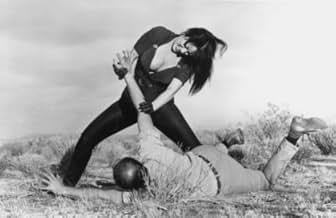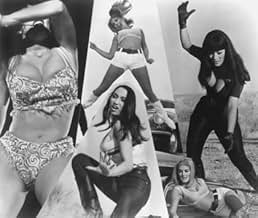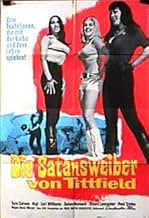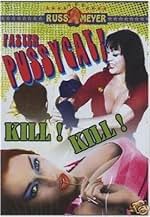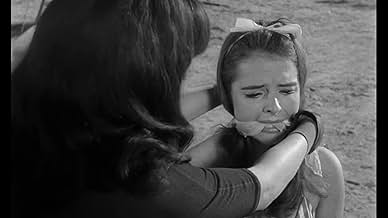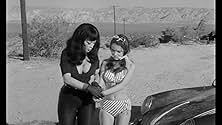CALIFICACIÓN DE IMDb
6.6/10
17 k
TU CALIFICACIÓN
Tres gogós secuestran a una niña y conocen a un hombre lisiado que vive con sus dos hijos en el desierto. Después de saber que guarda cierto dinero, las mujeres comienzan a conspirar contra ... Leer todoTres gogós secuestran a una niña y conocen a un hombre lisiado que vive con sus dos hijos en el desierto. Después de saber que guarda cierto dinero, las mujeres comienzan a conspirar contra él.Tres gogós secuestran a una niña y conocen a un hombre lisiado que vive con sus dos hijos en el desierto. Después de saber que guarda cierto dinero, las mujeres comienzan a conspirar contra él.
- Dirección
- Guionistas
- Elenco
Sue Bernard
- Linda
- (as Susan Bernard)
Michael Finn
- Gas Station Attendant
- (as Mickey Foxx)
John Furlong
- Narrator
- (voz)
- (sin créditos)
- Dirección
- Guionistas
- Todo el elenco y el equipo
- Producción, taquilla y más en IMDbPro
Argumento
¿Sabías que…?
- TriviaThe film's lead actress, Tura Satana, legally owned her image and likeness. So, whenever Russ Meyer wanted to change the artwork on any of the film's posters or re-release the film, he had to get her permission to do so and sometimes pay her royalties all over again.
- ErroresThe sign above the gas station misspells 'headquarters' as 'headquaters'.
- Versiones alternativasThis film is available in an unrated version on DVD.
- ConexionesEdited into White Zombie: Thunder Kiss '65 (1992)
Opinión destacada
Three go-go dancers - Varla (Tura Satana), Rosie (Haji) and Billie (Lori Williams) - are racing their sports cars out in the desert when they meet up with a young man named Tommy (Ray Barlow) and his girlfriend Linda (Susan Bernard). Tommy is an amateur car racer who has come out to do some time trials. Varla challenges him to a race. When she cuts him off with her car it leads to a fight and she kills him. Dragging the frightened Linda with them the trio go into the nearest town to fill up with petrol. There they see a muscly young man (Dennis Busch) carrying his crippled father (Stuart Lancaster) to his truck. The petrol station attendant (Mickey Foxx) tells the girls that the muscle man is retarded and that his bitter old father is reputed to be rich, but must have his riches stashed away somewhere at his isolated homestead. The girls decide to drop in for a visit hoping to find the old man's riches. They pass off Linda as a rich man's runaway daughter they are bringing home against her will. What they don't know is that the old man is a misogynist who delights in kidnapping women for his son, whom he refers to only as The Vegetable, to rape. They will have to rely on their own deadly talents and the possible decency of the old man's other son Kirk (Paul Trinka).
Russ Meyer's black and white "ode to the violence in women" made little impact when first released in 1965. Meyer had taken the world by storm with "The Immoral Mr. Teas" (1959), the film most often credited with kicking off the nudie cutie craze. And he would become a household name with the success of "Vixen!" (1968). But the films he made between those two landmarks, though some of them are among his best work, didn't attract much attention. But then John Waters, in his 1981 autobiography "Shock Value" wrote : "'Faster, Pussycat! Kill! Kill!'...is, beyond a doubt, the best movie ever made. It is possibly better than any film that will be made in the future." Waters dubbed Meyer "the Eisentein of sex films" because his use of skillful editing to get maximum impact out of scenes of sex and violence is reminiscent of the methods by which the Russian director managed to powerfully convey his political messages. Waters' championing of "Faster, Pussycat!", in particular, led to it becoming a favourite on college campus's across America.
If Meyer is "the Eisenstein of sex films" then "Faster, Pussycat! Kill! Kill!" is the "Citizen Kane" of trash films. I don't use the term disparagingly. For me a trash film is a film which appeals on a visceral rather than purely emotional level. In trash films realism is bad style. We must always know that we are watching a movie and enjoy it as a fantasy formed from our own base drives - from those uncivilised aspects of our nature that we must repress to live a civilised existence. Hence the term "trash" for the substance of these films is those aspects of ourselves which must be discarded. The violence in the trash film appeals to the knot in our stomach from every time we've had to bite back on our anger. It's prurient sexuality appeals to the lusts generated by everyday existence for which we may have insufficient outlet. We don't sympathise with the characters in a film like this, but we can identify with their actions because they take place in an obvious fantasy world. But the trash film has another appeal - the exhilaration that comes from the transgression of the bounds of good taste. And its sense of humour is the kind which elicits a belly-laugh. The anarchic spirit of the trash film has no less value than the more rarefied pleasures and intellectual stimulation of the art film.
What makes "Faster, Pussycat! Kill! Kill!" great is the way that it takes the sex and violence of the trash film and distills them into something more iconic than explicit. Unlike most of Meyer's films, there is no frontal nudity or sex scenes. The violence is powerful, but not extended or shown in gory detail. Yet Tura Satana in her tight black jeans, half-exposed breasts practically bursting free as she eyes up a man like a side of beef or takes him out with karate chop to the neck, distills any amount of sex and violence into a single unforgettable mythic figure. Similarly the vastly underrated Stuart Lancaster is the very personification of sleazy misogyny. Add to this the brilliant build-up of the opening monologue, Meyer's masterful editing and Jack Moran's eminently quotable and often hilariously funny camp dialogue and you have a trash film masterpiece that just gets better and better the more times you watch it.
Russ Meyer's black and white "ode to the violence in women" made little impact when first released in 1965. Meyer had taken the world by storm with "The Immoral Mr. Teas" (1959), the film most often credited with kicking off the nudie cutie craze. And he would become a household name with the success of "Vixen!" (1968). But the films he made between those two landmarks, though some of them are among his best work, didn't attract much attention. But then John Waters, in his 1981 autobiography "Shock Value" wrote : "'Faster, Pussycat! Kill! Kill!'...is, beyond a doubt, the best movie ever made. It is possibly better than any film that will be made in the future." Waters dubbed Meyer "the Eisentein of sex films" because his use of skillful editing to get maximum impact out of scenes of sex and violence is reminiscent of the methods by which the Russian director managed to powerfully convey his political messages. Waters' championing of "Faster, Pussycat!", in particular, led to it becoming a favourite on college campus's across America.
If Meyer is "the Eisenstein of sex films" then "Faster, Pussycat! Kill! Kill!" is the "Citizen Kane" of trash films. I don't use the term disparagingly. For me a trash film is a film which appeals on a visceral rather than purely emotional level. In trash films realism is bad style. We must always know that we are watching a movie and enjoy it as a fantasy formed from our own base drives - from those uncivilised aspects of our nature that we must repress to live a civilised existence. Hence the term "trash" for the substance of these films is those aspects of ourselves which must be discarded. The violence in the trash film appeals to the knot in our stomach from every time we've had to bite back on our anger. It's prurient sexuality appeals to the lusts generated by everyday existence for which we may have insufficient outlet. We don't sympathise with the characters in a film like this, but we can identify with their actions because they take place in an obvious fantasy world. But the trash film has another appeal - the exhilaration that comes from the transgression of the bounds of good taste. And its sense of humour is the kind which elicits a belly-laugh. The anarchic spirit of the trash film has no less value than the more rarefied pleasures and intellectual stimulation of the art film.
What makes "Faster, Pussycat! Kill! Kill!" great is the way that it takes the sex and violence of the trash film and distills them into something more iconic than explicit. Unlike most of Meyer's films, there is no frontal nudity or sex scenes. The violence is powerful, but not extended or shown in gory detail. Yet Tura Satana in her tight black jeans, half-exposed breasts practically bursting free as she eyes up a man like a side of beef or takes him out with karate chop to the neck, distills any amount of sex and violence into a single unforgettable mythic figure. Similarly the vastly underrated Stuart Lancaster is the very personification of sleazy misogyny. Add to this the brilliant build-up of the opening monologue, Meyer's masterful editing and Jack Moran's eminently quotable and often hilariously funny camp dialogue and you have a trash film masterpiece that just gets better and better the more times you watch it.
- pinback-3
- 2 oct 2006
- Enlace permanente
Selecciones populares
Inicia sesión para calificar y agrega a la lista de videos para obtener recomendaciones personalizadas
- How long is Faster, Pussycat! Kill! Kill!?Con tecnología de Alexa
Detalles
- Fecha de lanzamiento
- País de origen
- Idioma
- También se conoce como
- Faster Pussycat, Kill!... Kill!
- Locaciones de filmación
- Mojave Desert, California, Estados Unidos(General location at Randsburg and Johannesburg, two mining ghosttowns, and Ollie Pesch's Musical Wells Ranch for the dirty old man's ranch scenes.)
- Productoras
- Ver más créditos de la compañía en IMDbPro
Taquilla
- Presupuesto
- USD 45,000 (estimado)
- Tiempo de ejecución1 hora 23 minutos
- Color
- Mezcla de sonido
Contribuir a esta página
Sugiere una edición o agrega el contenido que falta

Principales brechas de datos
By what name was Faster, Pussycat! Kill! Kill! (1965) officially released in India in English?
Responda

